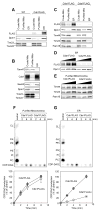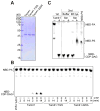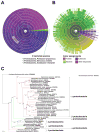Tam41 is a CDP-diacylglycerol synthase required for cardiolipin biosynthesis in mitochondria
- PMID: 23623749
- PMCID: PMC3654088
- DOI: 10.1016/j.cmet.2013.03.018
Tam41 is a CDP-diacylglycerol synthase required for cardiolipin biosynthesis in mitochondria
Abstract
CDP-diacylglycerol (CDP-DAG) is central to the phospholipid biosynthesis pathways in cells. A prevailing view is that only one CDP-DAG synthase named Cds1 is present in both the endoplasmic reticulum (ER) and mitochondrial inner membrane (IM) and mediates generation of CDP-DAG from phosphatidic acid (PA) and CTP. However, we demonstrate here by using yeast Saccharomyces cerevisiae as a model organism that Cds1 resides in the ER but not in mitochondria, and that Tam41, a highly conserved mitochondrial maintenance protein, directly catalyzes the formation of CDP-DAG from PA in the mitochondrial IM. We also find that inositol depletion by overexpressing an arrestin-related protein Art5 partially restores the defects of cell growth and CL synthesis in the absence of Tam41. The present findings unveil the missing step of the cardiolipin synthesis pathway in mitochondria as well as the flexibile regulation of phospholipid biosynthesis to respond to compromised CDP-DAG synthesis in mitochondria.
Copyright © 2013 Elsevier Inc. All rights reserved.
Figures







Similar articles
-
Crystal structure of Tam41 cytidine diphosphate diacylglycerol synthase from a Firmicutes bacterium.J Biochem. 2022 Mar 31;171(4):429-441. doi: 10.1093/jb/mvab154. J Biochem. 2022. PMID: 34964897
-
Mitochondrial CDP-diacylglycerol synthase activity is due to the peripheral protein, TAMM41 and not due to the integral membrane protein, CDP-diacylglycerol synthase 1.Biochim Biophys Acta Mol Cell Biol Lipids. 2018 Mar;1863(3):284-298. doi: 10.1016/j.bbalip.2017.12.005. Epub 2017 Dec 16. Biochim Biophys Acta Mol Cell Biol Lipids. 2018. PMID: 29253589 Free PMC article.
-
Structures of the Mitochondrial CDP-DAG Synthase Tam41 Suggest a Potential Lipid Substrate Pathway from Membrane to the Active Site.Structure. 2019 Aug 6;27(8):1258-1269.e4. doi: 10.1016/j.str.2019.04.017. Epub 2019 Jun 6. Structure. 2019. PMID: 31178220
-
CDP-Diacylglycerol Synthases (CDS): Gateway to Phosphatidylinositol and Cardiolipin Synthesis.Front Cell Dev Biol. 2020 Feb 7;8:63. doi: 10.3389/fcell.2020.00063. eCollection 2020. Front Cell Dev Biol. 2020. PMID: 32117988 Free PMC article. Review.
-
CDP-diacylglycerol, a critical intermediate in lipid metabolism.Chem Phys Lipids. 2020 Aug;230:104914. doi: 10.1016/j.chemphyslip.2020.104914. Epub 2020 Apr 28. Chem Phys Lipids. 2020. PMID: 32360136 Review.
Cited by
-
Neddylation inhibition prevents acetaminophen-induced liver damage by enhancing the anabolic cardiolipin pathway.Cell Rep Med. 2024 Jul 16;5(7):101653. doi: 10.1016/j.xcrm.2024.101653. Cell Rep Med. 2024. PMID: 39019009 Free PMC article.
-
Maintenance of Cardiolipin and Crista Structure Requires Cooperative Functions of Mitochondrial Dynamics and Phospholipid Transport.Cell Rep. 2019 Jan 15;26(3):518-528.e6. doi: 10.1016/j.celrep.2018.12.070. Cell Rep. 2019. PMID: 30650346 Free PMC article.
-
Tetra-linoleoyl cardiolipin depletion plays a major role in the pathogenesis of sarcopenia.Med Hypotheses. 2019 Jun;127:142-149. doi: 10.1016/j.mehy.2019.04.015. Epub 2019 Apr 17. Med Hypotheses. 2019. PMID: 31088638 Free PMC article.
-
Cardiolipin, the Mitochondrial Signature Lipid: Implication in Cancer.Int J Mol Sci. 2020 Oct 28;21(21):8031. doi: 10.3390/ijms21218031. Int J Mol Sci. 2020. PMID: 33126604 Free PMC article. Review.
-
Mitochondrial phospholipids: role in mitochondrial function.J Bioenerg Biomembr. 2016 Apr;48(2):99-112. doi: 10.1007/s10863-015-9601-4. J Bioenerg Biomembr. 2016. PMID: 25627476 Review.
References
-
- Chang SC, Heacock PN, Clancey CJ, Dowhan W. The PEL1 gene (renamed PGS1) encodes the phosphatidylglycero-phosphate synthase of Saccharomyces cerevisiae. J Biol Chem. 1998a;273:9829–9836. - PubMed
-
- Chang SC, Heacock PN, Mileykovskaya E, Voelker DR, Dowhan W. Isolation and characterization of the gene (CLS1) encoding cardiolipin synthase in Saccharomyces cerevisiae. J Biol Chem. 1998b;273:14933–14941. - PubMed
-
- Clancey CJ, Chang SC, Dowhan W. Cloning of a gene (PSD1) encoding phosphatidylserine decarboxylase from Saccharomyces cerevisiae by complementation of an Escherichia coli mutant. J Biol Chem. 1993;268:24580–24590. - PubMed
Publication types
MeSH terms
Substances
Grants and funding
LinkOut - more resources
Full Text Sources
Other Literature Sources
Molecular Biology Databases

